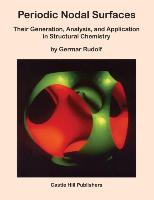Periodic Nodal Surfaces
BücherAngebote / Angebote:
Periodic what? This thesis has many illustrations of three-dimensional space dividers of a wide range of symmetries, some simple, some complex, but many of them simply gorgeous to look at. And that is all most people can appreciate about this thesis. The rest is for a handful of experts, also called crystallography nerds, who look at life from their ivory tower perspective. They might understand what follows. The rest of humanity I ask to please pardon my ranting:
Since the early 1970s relationships between the properties of periodic minimal surfaces (PMS) and a variety of phenomena from different disciplines of the natural sciences have been investigated. In the mid 1980s these investigations were expanded to encompass periodic potential surfaces (P0PS) and since the late 1980s also nodal surfaces (PNS). The concept of periodic nodal surfaces is, quite in contrast to both other methods, free of any physical implications and offers a broad variability while constraint by strict symmetry laws.
One main focus of this thesis is the complete analysis of characteristic structure factors S(hkl) for the systematic generation of periodic nodal surfaces. This analysis departs from the implicitly known, yet never comprehensively summarized symmetry selection laws of the reciprocal lattice vectors including their phase permutations. In analogy to the characteristic point configurations in real space, the characteristic structure factors S(hkl) of a certain symmetry are deducted for the reciprocal space. Tables are produced for the cubic, hexagonal, and trigonal crystal systems, which list the correlation between symmetry and structure factor type. Also considered are phase shifts caused by shifted origins.
Based on these results, numerous periodic nodal surfaces are introduced and analyzed, which have been calculated rather easily with Fourier sums. The analysis of mathematical properties regarding topology and symmetry yields a series of results which have been known from the other methods. Decisive new insights are gained, however, while analyzing the distribution of extrema of the generating Fourier series. They frequently exhibit constant or only slightly varying values along certain lines. Hence, besides the nodes it is particularly these line and line segment graphs which permit a characterization of PNS. Furthermore the surface areas and volumes of partial spaces separated by the surfaces can be determined easily, which is important for special questions of structural chemistry.
The exploration of hyperbolic, graphite like networks reveals topological and symmetrical patterns regarding the existence and variability of hypothetical new graphite modifications. This topological excursion into non-Euclidean geometry leads to generally valid relationships between frameworks of chemical compounds and mostly hyperbolic periodic nodal surfaces PNS.
The organization of chemical structures by periodic nodal surfaces is investigated, with many examples. It is demonstrated that already a relatively small amount of surface types permits the analysis and - sometimes very detailed - characterization of a broad range of different compounds. In some cases the concept of non-Euclidean layer structures leads to an improved understanding of complicated structures and to the discovery of overlooked details, for instance the layered organization of labyrinth water in faujasite.
Several topics are finally listed as suggestions for further research, where the concept of periodic nodal surfaces (PNS) could be applied just as successfully.
Folgt in ca. 5 Arbeitstagen




